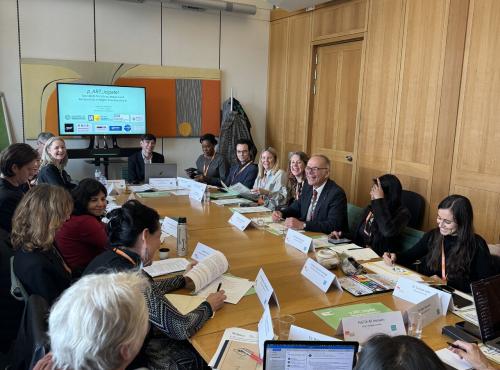10-Year Health Plan: Big Promises for Education and Workforce Planning but Even Bigger Questions
Last week, the Government unveiled its long-anticipated 10-Year Health Plan. Released during a turbulent week in Parliament, the strategy enters a political landscape marked by debate over the future of public services, including welfare, care, and the NHS.
Framed as a long-term vision for health and care in England, the plan sets out three major system shifts:
• From hospital to community
• From analogue to digital
• From sickness to prevention
The plan reaffirms a suite of existing policy initiatives and funding commitments, many of which echo the ambitions set out in the NHS Long Term Workforce Plan and Spending Review. Initial reactions to the three shifts were positive; however, questions remain over practicality and plans for implementation.
Within the plan, education played a key role, with a dedicated section on "An NHS Fit for the Future" laying out the goals for the future NHS workforce and setting ambitious plans for health education.
Making the NHS a Better Place to Work – In Theory
The plan rightly emphasises improving NHS staff experience. Commitments include new wellbeing standards, offering nutritious food and drink, expanded flexible working, and staff treatment hubs.
On paper, these are positive additions and, alongside working in an NHS less overwhelmed by backlogs and dehumanising A&E waiting times, could improve staff experience – if actually put in place. However, there's little detail on the practical aspects of how this will work.
Although the plan acknowledged the pressure that NHS staff at all levels are under, additional measures could in fact increase pressure on NHS colleagues.
The document outlined plans to enhance accountability and centre patient voice across the NHS. This is undoubtedly an important goal and comes at a moment of diminished public trust in the NHS, driven by high-profile failures like the Letby case and the death of Martha Mills – incidents that revealed dangerous silences across NHS systems and cultures.
However, one of the ways it suggests doing so is linking senior management pay to patient, taxpayer, and public satisfaction. But this proposed mechanism of accountability raises its own concerns. How will "patient satisfaction" be fairly assessed? How will performance metrics account for external pressures like understaffing, or the emotional state of patients and families navigating devastating news? More broadly, even if pay penalties are aimed at senior management, the pressure could quietly cascade to frontline clinicians already facing immense demands and burnout. Without nuance, top-down reforms risk entrenching more stress at the base, countering the aims to make the NHS an overall better place to work.
Curriculum Reform and Digital Ambitions
One of the bolder commitments in the plan is to overhaul health education curricula within three years – whilst also speeding up the reform process itself. It's an ambitious promise with little detail on how this would happen safely and sustainably, particularly given ongoing regulatory and staffing pressures in universities and colleges.
There is also a clear expectation that the next generation of NHS professionals will be AI-literate and digitally confident. This is undoubtedly the right direction. During a recent visit to Canterbury College as part of the Assistive Technology Commission, I saw students being trained on cutting-edge technology designed to improve patient independence and quality of care. They were excited by the new skills on offer and the potential to shape roles that don't yet exist.
But scaling this kind of innovation will require serious investment – in facilities, staff training, and infrastructure – and flexibility within pre-existing budgets to not only upskill new entrants but existing staff, some of whom in the social care space especially are themselves at risk of being digitally excluded.
As Eli, a medical student, points out: “At my current trust, all but A&E use paper notes. The internet is too slow and there are not enough computers – and they break frequently. Patients' notes often get separated, and there is little to no ability to look up a patient who isn't on your ward, because you can't read any of the documentation. The idea AI will revolutionise staff time at the moment seems like a fantasy.”
We can't expect to equip a digitally fluent workforce without first equipping the institutions – and placements – that train them. This also raises broader concerns about teaching capacity within HE and FE institutions, which are themselves grappling with workload and resourcing constraints.
A Career Worth Choosing and Staying In
The plan places welcome emphasis on making NHS careers more attractive and flexible. It promotes the idea of "skills escalators" and training based on competencies, rather than rigid professional roles. This is a promising shift and directly relevant to existing sector debates – for example, there's been a longstanding call by nursing educators to move away from the rigid 2,300 placement hour requirement towards a task-based, competency-focused model, and reforms like this could make progress in this regard.
Still, caution is needed. The plan reflects briefly on past missteps – including the controversial rollout of the Physician Associate role and the medical degree apprenticeship. These initiatives were intended to expand capacity and widen access but instead triggered backlash and, in some cases, compromised patient safety.
This should act as a costly reminder that expanding training pathways without integration or proper evaluation can do more harm than good. The plan continues to promote new roles and alternative routes in healthcare, and whilst this could lead to positive innovations, it risks adding strain to an already fragmented system.
Nursing Education: Moving from Words to Action
The plan acknowledged the ongoing challenge of recruiting students into nursing programmes. It promises a forthcoming Professional Strategy for Nursing and Midwifery and outlines efforts to improve funding mechanisms – including quicker travel reimbursements and a reduced delay between course completion and qualification. It also pledges 2,000 new nursing apprenticeships, targeted to areas with the greatest need.
This is welcome. But the challenges are longstanding and multifaceted – from perceptions of the profession to gender imbalance to undervaluation of nurses' technical expertise. Reforms must address these broader issues too. Recent efforts to crack down on fraudulent nursing qualifications were a positive start; the forthcoming strategy must build on this momentum.
Medical Education: Only Part of the Pipeline
When it comes to training doctors, the plan includes several specific measures around medical training: the addition of 1,000 specialty training posts, a commitment to prioritise UK graduates for these posts, and a forthcoming review of medical training led by Sir Chris Whitty and Sir Stephen Powis. These are by and large supported decisions – but they address only a narrow slice of the medical education pipeline.
Notably absent is any reference to issues within the Foundation Year (F1/F2) system. The current model allocates placements through a national algorithm that can feel arbitrary and opaque. Students have little control, and the wide geographical spread of deaneries can create wildly different clinical experiences. There's also the troubling rise of "placeholder" jobs for unmatched graduates, with some students only learning their confirmed placements weeks before starting. Hopefully, the upcoming review will tackle these longstanding frustrations.
Whilst the review is focussed on postgraduate training, undergraduate challenges are equally pressing. For example, many students face a steep drop in financial support after year four in their medical degree, when NHS bursaries kick in but often fall short. Some receive as little as £7,500 during full-time clinical placements – making part-time work almost unavoidable, even as academic and clinical demands increase.
It was positive to see the plan call for specific measures to tackle widening access – such as targeting institutions with a track record of widening access and plans for better support and signposting during applications. However, if the NHS is to serve as a vehicle for social mobility, then supporting students through – not just into – medical school must be a priority. Part of this is fixing the funding structures like the fourth year drop that disproportionately affect students from lower socioeconomic backgrounds.
Time to Teach, Time to Train and Time to Innovate
A consistent theme throughout the plan is the need to expand teaching capacity to deliver these ambitious reforms.
There's a growing shortage of clinical educators in the FE and HE sectors, and even those in post are stretched thin with other clinical demands. The review makes plans to expand clinical educator places and capacity but again lacks detail on how.
Whilst the review suggests that AI and other technologies might free up time, it's unclear whether these efficiencies will materialise soon – or at all. Even promising time-saving tools like AI scribes require initial training, integration, and ongoing adaptation.
In a stretched service, any hours freed up are more likely to go towards urgent patient care than curriculum development or teaching. The promise of technological relief shouldn't distract from the immediate need to recruit, support, and retain educators.
International Staff, Immigration, and Workforce Reality
The plan also includes a commitment to reduce international recruitment to less than 10% by 2035 – framed as a move away from reliance on workers from lower-income countries. Whilst this raises valid ethical concerns around brain drain, it also poses a real risk to current service delivery. The NHS still relies heavily on international staff, and sudden contraction could create critical gaps.
At the same time, the plan entertains the idea of UK-registered professionals working abroad whilst delivering NHS services remotely – a confusing juxtaposition that undercuts the ethical argument made for reducing international doctor numbers in the first place.
So: With What Money – and What Capacity?
Ultimately, the 10-year health plan reads as a wish list more than a roadmap. Most of the proposals are desirable – even overdue – but it remains unclear whether the system has the resources, time, or people to make them real.
Clinicians and educators are already firefighting. Implementing large-scale reform will hinge on two fundamentals: money and capacity. Despite a £30 billion funding boost in the Spending Review, there remains lingering doubt about how the NHS will finance these proposals.
We now await the promised 10-year workforce plan due later this year. That document cannot simply reiterate high-level ambitions. It must provide detailed, actionable pathways – with clarity on responsibility, timelines, and above all, funding.



